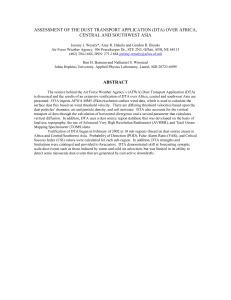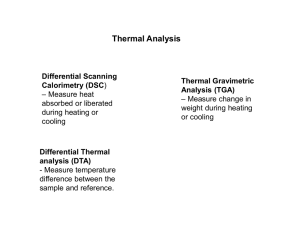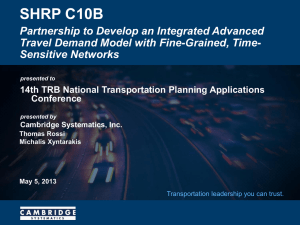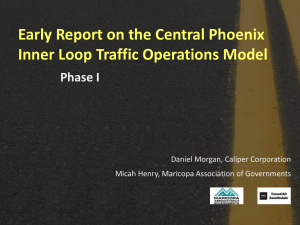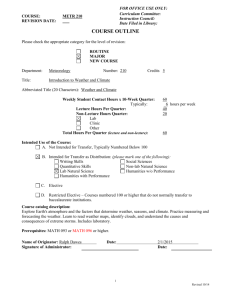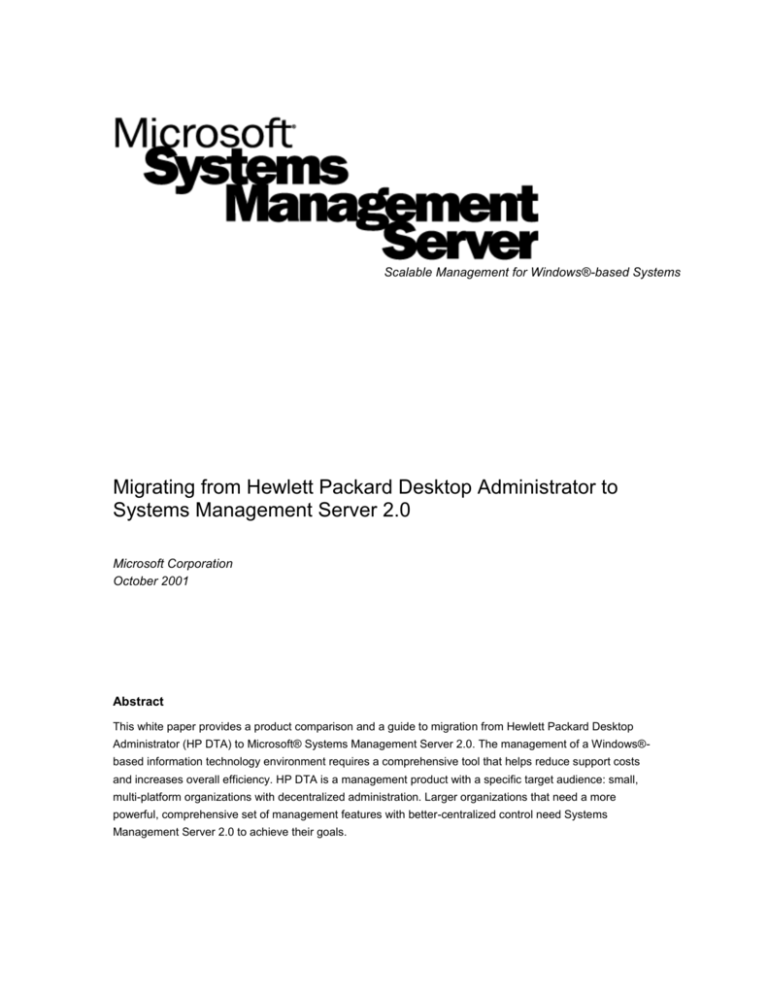
Scalable Management for Windows®-based Systems
Migrating from Hewlett Packard Desktop Administrator to
Systems Management Server 2.0
Microsoft Corporation
October 2001
Abstract
This white paper provides a product comparison and a guide to migration from Hewlett Packard Desktop
Administrator (HP DTA) to Microsoft® Systems Management Server 2.0. The management of a Windows®based information technology environment requires a comprehensive tool that helps reduce support costs
and increases overall efficiency. HP DTA is a management product with a specific target audience: small,
multi-platform organizations with decentralized administration. Larger organizations that need a more
powerful, comprehensive set of management features with better-centralized control need Systems
Management Server 2.0 to achieve their goals.
The information contained in this document represents the current
view of Microsoft Corporation on the issues discussed as of the date
of publication. Because Microsoft must respond to changing market
conditions, it should not be interpreted to be a commitment on the
part of Microsoft, and Microsoft cannot guarantee the accuracy of
any information presented after the date of publication.
This White Paper is for informational purposes only. MICROSOFT
MAKES NO WARRANTIES, EXPRESS OR IMPLIED, AS TO THE
INFORMATION IN THIS DOCUMENT.
Complying with all applicable copyright laws is the responsibility of
the user. Without limiting the rights under copyright, no part of this
document may be reproduced, stored in or introduced into a retrieval
system, or transmitted in any form or by any means (electronic,
mechanical, photocopying, recording, or otherwise), or for any
purpose, without the express written permission of Microsoft
Corporation.
Microsoft may have patents, patent applications, trademarks,
copyrights, or other intellectual property rights covering subject
matter in this document. Except as expressly provided in any written
license agreement from Microsoft, the furnishing of this document
does not give you any license to these patents, trademarks,
copyrights, or other intellectual property.
© 2001 Microsoft Corporation. All rights reserved.
Microsoft, Windows, and Windows NT are either registered
trademarks or trademarks of Microsoft Corporation in the United
States and/or other countries.
The names of actual companies and products mentioned herein may
be the trademarks of their respective owners.
Contents
Contents ......................................................................................................................................... 3
Introduction .................................................................................................................................... 1
Overview ......................................................................................................................................... 2
Product Comparison ..................................................................................................................... 3
Migration to Systems Management Server ............................................................................... 14
Extensibility.................................................................................................................................. 16
Related Links ............................................................................................................................... 18
Introduction
Why was this paper written?
In July of 2000, Hewlett Packard announced that it would no longer be selling its Desktop
Administrator product (hereafter referred to as HP DTA). Existing HP DTA customers now must
change their management platform to an alternative solution.
This paper outlines how Microsoft® Systems Management Server 2.0 is an alternative for HP
DTA customers who want to manage Windows®-based desktops and servers. This paper covers
not only the specific Systems Management Server attributes that make it an ideal Windows
management solution, but also how companies can painlessly migrate to it from an existing HP
DTA environment.
What is in this paper?
This migration-planning document provides the reader with overview information about the
features and functions of Systems Management Server and HP DTA, and how those features
compare to each other. The following sections discuss the differences in the implementation
architecture of the two products, and then explain the steps for planning and executing a
migration from HP DTA to Systems Management Server.
The contents of the migration planning include:
Planning migration of DTA features to Systems Management Server features
Migrating packages/scripts
Preparation of environment
Process of migration/implementation
Best Practices
Migrating from Hewlett Packard Desktop Administrator to Systems Management Server 2.0
1
Overview
Overview of Systems Management Server
Microsoft Systems Management Server 2.0 includes detailed hardware inventory, software
inventory and metering, software distribution and installation, and remote troubleshooting tools.
These integrated features make Systems Management Server 2.0 the most scalable way to
reduce the cost of change and configuration management for Windows-based desktop and server
systems. Systems Management Server 2.0 is built on industry-standard management protocols,
ensuring compatibility with complementary management tools. Systems Management Server 2.0
is tightly integrated with Microsoft SQL Server and Microsoft Windows NT® Server operating
system, making it easier than ever to install, configure, and maintain Systems Management
Server in any size network.
Conversely, HP DTA has limited, or non-existent, integration features within the various modules
of the product. There are also no third-party extensions to DTA, making integration with other
management tools in your organization impossible. Additionally, the following key product
features in Systems Management Server have clear advantages:
Inventory agents – Industry-standard inventory mechanisms allow Systems Management
Server to provide an infinite level of detail (whereas HP DTA is limited to a known list of
hardware or software).
Software distribution – Because of its integration with the inventory database, Systems
Management Serve is able to provide advanced distribution targeting capabilities, for
example, to domain users or groups. Bandwidth throttling features are also available in
Systems Management Server (unlike in HP DTA, which lacks both the bandwidth throttling
and integration with the inventory database).
Help desk tools – Remote control out of the box, and numerous live help desk facilities that
are described in this paper (which are not available with HP DTA).
Lastly, note that Systems Management Server 2.0 is very easy to install and configure out of the
box. The installation and configuration is wizard driven just like most current Microsoft products.
The difficulties experienced during HP DTA’s cumbersome installation process do not occur
during your installation of Systems Management Server. In fact, this paper demonstrates that
Systems Management Server is the best option for an HP DTA customer who needs a solid
migration path.
Migrating from Hewlett Packard Desktop Administrator to Systems Management Server 2.0
2
Product Comparison
Moving up to Systems Management Server
Microsoft Systems Management Server and HP Desktop Administrator use similar features and
terminology to support their objectives. Note, however, that the implementation of each product is
radically different, and because DTA has not been updated since 1997, the technology cannot be
compared to the technology in Systems Management Server. Both products employ the following
features, to name a few:
Software and Hardware Inventory
Software Distribution
Remote Help Desk Tools
Software Metering
Both products make use of similar terms such as sites, agents, queries and scripting. This paper
differentiates the use of these terms to prevent confusion during or after the migration.
Features
As indicated earlier, both HP DTA and Microsoft Systems Management Server appear to perform
similar functions when briefly reviewed. However, the following table compares all of the features
and describes their functions in each product.
Migrating from Hewlett Packard Desktop Administrator to Systems Management Server 2.0
3
Planning Tools
Feature
Description
Hardware Inventory
Both products use an inventory agent to collect hardware inventory.
However, the way in which data is collected from computer hardware is quite
different.
HP DTA uses pre-defined tests to compare user hardware to known
specifications (given by the vendor—HP, Dell, Compaq, and so forth) and
then reports the test results. This is a very poor way to identify hardware, as
there must first be a baseline for the agent to compare against.
Systems Management Server has no such limitations on access to
information. Rather, SMS 2.0 takes advantage of the common information
model (CIM) format (which is a standard piece of the Windows operating
system known as WMI), and uses a CIM-based agent to get information out
of all 32-bit Windows operating systems. This means that data can be
accessed from many sources, including Win32, SNMP, and DMI, making for
a much richer collection of inventory information. Over 200 properties are
collected and reported in SMS (compared to DTA, in which the amount and
detail of information collected varies by hardware manufacturer). In fact,
because WMI is built into the Windows operating system, it allows Systems
Management Server to employ a much smaller and cleaner agent than DTA.
Software Inventory
With HP DTA hardware inventory, software is collected based on an auditing
policy where the software on the user PC is compared with a known list of
software, producing the inventory result. This is cumbersome and troubled
with overhead on the client and the administration side.
To deliver the best software inventory available on the Windows platform,
Systems Management Server 2.0 searches for version resource information
on every executable on the client machine, rather than checking against a
predefined database. This provides a dynamic, efficient mechanism of
getting detailed information about every application on every PC.
Administrators receive a list of all the software packages on a client machine,
grouped under the company that manufactured them. As well as returning
information on recognized applications, Systems Management Server
returns a list of all unknown applicationsthose without header information.
If there are specific custom applications that are important to trace but do not
have full header information, they can still be discovered.
Compliance Checking
HP DTA has no function similar to Compliance Checking that can be used to
compare end user desktops to the known standard of an organization. For
example, Systems Management Server can also be used to test for Windows
2000 compatibility or Euro compliance.
Software Metering
The technologies are somewhat similar in the two products, and both offer
the ability to actively or passively monitor software usage.
The Systems Management Server software metering implementation is
based on a three-tier model: the site server acts as the central point for
metering policy, a local metering server provides real-time verification of
applications, and a client component monitors and controls applications
being started on the desktop. This three-tier model provides both redundancy
and WAN-sensitivity to the metering solution.
Network Discovery
There is no such feature in HP DTA.
Network Discovery automatically uses the internet protocol (IP) subnets in
your organization to discover every IP-enabled device on the network
Migrating from Hewlett Packard Desktop Administrator to Systems Management Server 2.0
4
Feature
Description
(computers, workstations, servers). Administrators can use this information
for many purposes:
Reporting
To determine the Windows machines on which to deploy the agents
To target machines for the installation of agents
To count how many machines are on your network and where they
reside
To count IP printers and other non-Windows IP-based devices
HP DTA includes a Report Writer function that allows you to write your own
reports, but has no built-in example reports and no web-based reporting
tools.
Systems Management Server has built-in, graphical reports that can be
easily customized to suit any need.
Microsoft has also recently released a Web-based reporting tool for
customers of Systems Management Server to improve the built-in reporting
functionality, as well as allow more ways for enterprise customers to
leverage existing tools to access the rich data in Systems Management
Server.
Migrating from Hewlett Packard Desktop Administrator to Systems Management Server 2.0
5
Deployment Tools
Feature
Description
Electronic Software
Distribution
Systems Management Server 2.0 provides the most feature-rich set of
options for targeting software distribution on the Windows platform. In
addition to targeting machines (as in HP DTA and SMS 1.2), Systems
Management Server 2.0 can distribute to the following:
Users
User groups
TCP/IP network segments
Machines
This allows applications to be sent in a more directed manner and is
completely integrated with your Windows domain. For instance, a single
Windows NT user group could be sent a software update that was relevant to
only them, or, all machines in a particular network segment could be sent a
driver pertaining to the printer in that specific segment.
Systems Management Server also contains many facilities geared toward
supporting software distribution in a WAN environment, such as senders,
bandwidth profiling, retries, compression, a courier sender (packages via
CD-ROM) and fan-out distribution. With Microsoft’s Active Directory
integration tool (available for download), SMS can now target software
distribution jobs based on your Active Directory infrastructure.
Integrated Inventory
HP DTA does not allow ESD to be integrated with the inventory database.
Systems Management Server has this ability and therefore ensures that only
compatible systems install software. This accurate inventory makes software
distribution more reliable.
ESD integrated with the hardware and software inventory means that the
administrator can more accurately target software, and can use dynamic
options to specify the intended target. Systems Management Server
distribution tools are WAN-sensitive and can control the amount of bandwidth
generated by a large package.
Rules-Based Software
Distribution
Because HP DTA is not tightly integrated with its inventory database, it
cannot provide this feature.
Systems Management Server can dynamically add or remove machines,
users, or user groups from collections, based on criteria set by the
administrator. Software is then installed or removed automatically as users or
machines are added and removed from these collections. The end result is
that your software distributions go to all the computers that meet your
collection criteria—even those computers that were added to the network
after you created the collection. (HP DTA does not make these dynamic
changes and therefore administrators must constantly attend to distribution
targets.)
Scheduled Software
Distribution
HP DTA allows jobs to be scheduled at pre-determined times, but is not able
to intelligently schedule distribution based on dynamic criteria such as
available network bandwidth.
Systems Management Server 2.0 provides key tools to allow administrators
to schedule distributions outside of critical business hours. For example, a
specific time of day can be indicated, or the installation can be set to happen
when the user is not actually logged on. It is also possible to schedule
distribution based on network bandwidth, thereby ensuring package delivery
Migrating from Hewlett Packard Desktop Administrator to Systems Management Server 2.0
6
Feature
Description
does not affect other network tasks.
Packages and Package
Installation
HP DTA includes BasicScript, which provides a programming language for
creating, compiling, executing, and debugging scripts. These scripts are
used to create installation packages. BasicScript requires some basic
programming ability in order to be effective.
Systems Management Server provides a completely automated installation
tool called the SMS Installer that allows administrators to repackage changes
without any programming knowledge. SMS Installer is very simple to use in
this automated mode (requires no programming knowledge), but is also
flexible enough to allow the administrator to view the code and manually
configure a package in a similar manner to DTA.
Microsoft recently released an updated packaging tool (available for
download; see Related Links section). This tool automatically creates
packages out of any MSI files, and can convert older packages to MSI as
well.
Also note that one of the strongest features of packaging is that it takes full
advantage of Windows Installer, which allows for things such as self-healing
and the ability to install software features when required.
Unattended Software
Installation
Some applications need to be installed in a user context in order to set up
the appropriate icons; others need administrator rights to access system
configurations. Often a user without local administrative privilege needs to
install software that requires higher privileges.
HP DTA has no facility for installing under an administrative context;
therefore, automated package distribution to low-rights users is impossible.
Systems Management Server can deal with these situations because it is
able to use its own administrator privileges on that computer to install the
software.
Integrated Status
System
An administrator troubleshooting an HP DTA implementation is limited to
using log files and the “hit-or-miss” approach of using command line
switches, scripts, or complex debugging utilities. The system lacks the
integration to effectively report on its own status.
Systems Management Server includes functionality to generate real-time
status information and status reports on many aspects of the operation of the
product. As a component performs operations, it periodically generates
messages about its performance. These messages are transmitted to the
Status Manager, which decides where they should go based upon a set of
configurable rules. The status system is directly integrated into the admin
console and the Windows Event Log.
Migrating from Hewlett Packard Desktop Administrator to Systems Management Server 2.0
7
Diagnostic Tools in System Management Server
HP DTA does not include any of the diagnostic tools outlined in this section. However, for
reference the Systems Management Server diagnostic tools are described below.
Feature
Description
Network Trace
This feature builds a map of network servers and devices to help
administrators understand and troubleshoot the network. Network Trace
uses the server and network discovery information contained in the Systems
Management Server Discovery Database. After server discovery is
completed, Network Trace can map site systems within a site. After network
discovery is completed, Network Trace can map routers and links between
site systems.
Network Monitor
Network Monitor is a traffic analyzer tool that helps administrators find
network problems.
The Systems Management Server Network Monitor allows you to analyze
network traffic and pinpoint problems or potential bottlenecks. With Network
Monitor, administrators can:
Capture frames (also called packets) directly from the network.
Display and filter captured frames.
Edit and transmit captured frames onto the network to test network
resources or reproduce network problems.
Capture frames on a remote computer and display the capture statistics
on the local computer at intervals that you specify.
Network Monitor provides a secure solution by announcing its presence on
the network (by sending a frame) at regular intervals. This allows
administrators to prevent unauthorized users from sniffing packets using this
tool.
Remote Diagnostic
Tools
These tools reduce the time it takes to fix problems on servers and desktops
on the network by remotely running applications, chatting with end users,
rebooting, and even controlling the keyboard and mouse.
Systems Management Server provides a series of help desk utilities to
enable administrators to troubleshoot user problems. Remote control, remote
reboot, remote chat, file transfer and remote execute are all included with
System Management Server.
(Note that HP DTA uses Symantec pcANYWHERE for remote control, but it
is obtained separately from DTA and is not an integrated feature as in SMS.)
Migrating from Hewlett Packard Desktop Administrator to Systems Management Server 2.0
8
Architectural and Terminology Differences
In order to appropriately plan a migration from HP DTA to Microsoft Systems Management
Server, it is important to understand the overlap in terminology between the respective
implementations. This section explains how the same terms are used differently for each product.
Sites
Both Systems Management Server and HP DTA use the concept of sites. This section compares
Systems Management Server and DTA sites by giving a brief overview of each product’s basic
architecture, and then applying that information to an example organization.
Systems Management Server is organized into a hierarchy of sites. At the top of the hierarchy is
the Central Site, which must be a primary site. A primary site has a SQL Server database, where
hardware and software inventory information for the site and all sub sites beneath it in the
hierarchy is stored. A secondary site does not have a database and is administered from any site
above it in the hierarchy. A parent site is any Systems Management Server site that has one or
more sub sites below it. A child site is any Systems Management Server site that has a parent
site.
Systems Management Server Sites are created using your network structure as a model for site
placement. Sites are placed in locations where the number of clients or administration
requirements (or both) exceeds the available network bandwidth. For example, you might have a
central office in Los Angeles, and branch offices in Chicago and New York. Los Angeles has
2500 clients, Chicago has 750 clients, and New York has 350 clients. Chicago and New York are
both connected back to the hub site (Los Angeles) through relatively slow speed links.
Migrating from Hewlett Packard Desktop Administrator to Systems Management Server 2.0
9
The available network bandwidth between the remote sites and the central site is limited;
therefore, you determine that site servers are required in these locations.
Figure 1 Systems Management Server Site Concept
Server
Laptop
Computer
Los Angeles
Central (Parent) Site
2500 Clients
N
8K
12
VP
56
K
VP
N
Server
Server
Laptop
Laptop
Computer
Chicago
Secondary (Child) Site
Computer
750 Clients
New York
Secondary (Child) Site
350 Clients
Rather than following the geography of your network like Systems Management Server, HP DTA
sites are based on pre-defined groups of servers and workstations on which the different
components of the product run.
A single DTA site is typically implemented under the following conditions:
Network with fewer than 500 workstations
One login server
Workstations reside on a single LAN and use a network connection of 10 MB or faster.
A DTA site tree (multiple sites) is implemented if the network meets any of the following criteria:
More than 500 workstations
Two or more login servers
Workstations reside on more than one LAN, with network links of varying speeds, such as T1
or 256K links.
Migrating from Hewlett Packard Desktop Administrator to Systems Management Server 2.0
10
Looking at the same example network, you can clearly see that a large HP DTA environment of
interconnected networks and more than a few hundred workstations can lead to an enormous
number of sites and considerable complexity for administrators who are trying to locate a client
within the site hierarchy.
Figure 2 HP DTA Site Concept
Server
Server
Laptop
Server
Laptop
Computer
Laptop
Computer
500 Clients
Computer
500 Clients
500 Clients
Minimum 5 sites
Server
Server
Laptop
Computer
Laptop
Computer
500 Clients
500 Clients
Los Angeles
VP
N
K
56
N
VP
8K
12
Server
Server
Server
Laptop
Laptop
Laptop
Computer
Computer
500 Clients
250 Clients
Minimum 2 sites
Computer
New York
350 Clients
Chicago
This issue of complexity in locating a client machine does not exist in Systems Management
Server 2.0, because the system architects create a logical structure that overlaps the existing
network. Administrators do not have to search through multiple site databases to locate a client,
because Systems Management Server database objects are unified in the console. Systems
Management Server clients can be logically grouped in any way that the system administrators
choose, using collections (a group of computers or users based on dynamic rules).
Migrating from Hewlett Packard Desktop Administrator to Systems Management Server 2.0
11
Logon Servers
Used by both HP DTA and Systems Management Server, the term Logon Servers (also known as
logon points) refer to the initial point of contact between the client computer and the Systems
Management Server environment. The client runs the logon script, determines which sites it is a
member of, and finds a client access point (CAP), which may or may not be the logon point.
Systems Management Server allows you to configure CAP servers separate from logon servers.
This gives the administrator the flexibility to distribute the client load among, if necessary,
dedicated servers and minimally affect domain controllers.
The HP DTA implementation of logon servers is similar; however, the installation point and the
point where the user logs on are the same. Therefore, the logon points (that is, domain
controllers) must handle the entire load of client initiation and installation. This can create
unwanted congestion on your domain controllers.
Clearly, there is an advantage with Systems Management Server because you are able to
implement separate Logon Servers and CAP servers, or combine the two services as your needs
dictate.
Replication
Both products employ this term. At a basic level, Systems Management Server uses a thread
service named the Replication Manager that processes both incoming and outgoing site-to-site
replication. Replication Manager incorporates objects into replication files. Then, it passes these
files to the Scheduler as mini jobs that are to be sent to the appropriate locations by a sender.
Replication Manager also analyzes incoming files, and if appropriate, replicates the objects to
appropriate directories on the site server.
The true power of Systems Management Server replication, however, is its ability to configure
and control traffic between Sites. Systems Management Server has the ability to limit bandwidth
consumption between sites by a percentage of available bandwidth. Systems Management
Server also is able to schedule usage on the basis of data priority and business hours of
operation. In this way, you could prohibit all but high-priority inter-site communications during
critical business hours, and open the communications stream outside these hours.
HP DTA moves data among and within sites using a replication process. Databases at each site
store DTA data about computers at that site, as well as data from child sites. The DTA site
manager adds this data to databases by replicating new and changed data from site to site.
However, DTA has no ability to control the use of bandwidth between sites, as can SMS. With the
potentially large number of sites that must be created within an organization, the amount of traffic
generated could be significant.
Agents
Client features provide Systems Management Server 2.0 functionality to client computers, rather
than to site systems. Systems Management Server provides each client feature using client
agents that run on the client and deliver the client side of each feature’s functionality. You enable
Migrating from Hewlett Packard Desktop Administrator to Systems Management Server 2.0
12
and configure client features at the site level using the Administrator console, and these settings
affect every client within the site.
When Systems Management Server installs clients, the client agents that provide the features
you have enabled (such as software distribution) are installed along with the base client
components. If you do not enable client features before client installation, you can enable them
after the client has been installed. In that case, the related client agent is installed on each client
after you enable the feature. The installation and configuration of Systems Management Server
client agents is performed very easily using a graphical interface and simple point-and-click. Also
note that because both Systems Management Server and the Windows platform are relatives in
the Microsoft family, the client agents are extremely “Windows-friendly” and compatible. This
means minimal system overhead and maximum stability for the end user’s desktop.
In contrast to Systems Management Server, with HP DTA, the mentality is “all or nothing.” You
can either have all the client components installed everywhere in the site, or none at all. There is
very little customization that can be done to client agents, and it is not possible to make
configuration changes at the client machine or provide policy control over the agents as you can
with SMS.
Migrating from Hewlett Packard Desktop Administrator to Systems Management Server 2.0
13
Migration to Systems Management Server
Planning the Migration
Before any migration, your organization should first create a detailed plan of how you want to
configure Systems Management Server in your environment. You can find detailed planning
guides in the Systems Management Server Deployment page found on
http://www.microsoft.com/smsmgmt/deployment/default.asp.
This paper is intended to give additional tips and best practices on co-existence between, and
migration strategies from, Hewlett Packard’s Desktop Administrator to Microsoft’s Systems
Management Server 2.0.
Best Practices
As a result of consulting engagements with our enterprise customers, Microsoft Consulting
Services has identified a list of best practices for migrations from HP DTA to Systems
Management Server. This section describes those best practices that can be applied to ensure a
successful migration.
Test Environment. In many cases, HP DTA and its modules can co-exist quite well with
Systems Management Server during migration periods. However, you are always wise to
check each of their specific configurations in a test environment first. In your test
environment, you should match production as closely as possible.
Co-existence. A well-planned and tested migration and temporary co-existence of the two
products will provide your administrators enough time to adjust to the new Systems
Management Server system, and will minimize client down time. In this way, you never have
a situation where a large number of clients have no management solution installed. Running
the systems side-by-side allows your administrators transition time, and can facilitate learning
the new tools. In most cases, they will find that their management tasks are now much easier
to complete, and the unified interface (Microsoft Management Console) reduces the number
of tools that administrators must learn.
Site design. The architectural differences between the two products require a new site
design. It is important that the system planners in the organization have been through some
training (either formal, or, perhaps, informal, through the engagement process) to ensure that
everyone is using the same terminology. In most large organizations, the greatly reduced
number of sites allows for a much-simplified architecture.
Hardware. Perform a thorough evaluation of all hardware resources. Overall differences in
hardware requirements may necessitate new purchases, re-allocation, or configuration of
server resources. This may be an issue if a long time has passed since the initial deployment
of the site servers and the hardware is now out-of-date. For example, if your HP DTA site
server is a Pentium 100 with 64 MB of RAM, you will very likely need to replace it. However,
in some cases you might have perfectly adequate hardware that can be reused in your
Systems Management Server implementation. Many companies perform migrations in a
systematic fashion, where one or two new servers are purchased, and subsequent systems
are implemented as they are retired and rebuilt through the migration.
Migrating from Hewlett Packard Desktop Administrator to Systems Management Server 2.0
14
Servers. Because the two products use different system-type roles, you should create a
server migration plan. For example, you may want to have extra servers available while
infrastructure components are moved and replaced.
Training. Identify specific training requirements and draft a plan. The training plan should
include IT staff (such as the help desk and support staff), as well as the end-user. Emphasize
re-education on the new processes and procedures, and be sure to address all aspects and
components that were used and replaced (from the HP DTA implementation).
Contingency. The pilot and deployment plans must have identified all interim plans for
system outages. For example, while HP DTA software distribution is being removed and
replaced, there needs to be a contingency for package deployment. This also applies
significantly to the help desk if they are using remote control for support and these services
become temporarily unavailable during the migration. Running the Systems Management
Server and HP DTA environments in tandem can help alleviate significant periods of
downtime. (See co-existence mentioned earlier.)
Recovery. Due to the architectural differences between the two products, and
implementation of new hardware or reconfiguration of existing hardware, the migration may
require a new data recovery plan, or modification of current plans. It is imperative to involve
system operations in the migration process to ensure that backup jobs, offsite storage, and
other recovery components are updated.
De-install. Client DTA agent de-install and Systems Management Server client install need
to be thoroughly tested on a machine-by-machine basis. In addition, you must allow time for
system changes to take place. For example, allow time for HP DTA agents to completely deinstall (usually requires a reboot) and ensure that the system is “clean” (free from DTA
components) before starting the Systems Management Server install. Also, you must have a
mechanism in place to ensure that a client has been de-installed before you install Systems
Management Server; this can be as simple as batch-file system checks in the installation file.
Migrating from Hewlett Packard Desktop Administrator to Systems Management Server 2.0
15
Extensibility
Although HP DTA provides limited integration with third-party products (such as Remedy), many
specialized solutions have been developed by Microsoft’s systems management partners. This
section gives a brief overview of some of the companies that have developed integration
capabilities for Microsoft Systems Management Server 2.0 and Windows 2000 management
technologies.
Additionally, Microsoft has developed Microsoft Operations Manager 2000 (MOM), which
complements the capabilities of Systems Management Server. While Systems Management
Server delivers change and configuration management for desktops and servers, MOM handles
the operational management of servers and applications. Most enterprises will need both
products, and will benefit from their complementary operations.
A combination of the following third-party products—used in conjunction with Systems
Management Server, MOM, and Windows 2000— provides greater manageability in all areas of
the system.
1E's SMSwakeUp integrates Wake-on-LAN technology with Systems Management Server 2.0.
SMSWakeUp ensures that PCs are fully powered on when a Systems Management Server
advertisement becomes available.
Aelita SnapReports is an integrated, scalable, and easy-to-deploy HTML reporting system for
Systems Management Server 2.0.
Callisto Software’s Orbiter SMS Connector extends Systems Management Server support for
the mobile computing environment.
Altiris provides a number of add-ons to Systems Management Server to natively support: mobile
and remote users (inventory and software distribution), enhanced inventory collection, Unix
systems, Leased systems, Web Administration, Web Reporting, Serial Number and Exchange
integration.
Fujitsu has integrated the company’s SystemWalker systems and network management solution
with Systems Management Server.
Full Armor provides policy management solutions for system policies (flexible lockdown) and
group policies (RSoP and extensive management).
Gravity Square Inc. provides value-added solutions that integrate with Systems Management
Server 2.0 to help reduce cost-based usage of system resources, software distribution time,
system down time during billable hours, and advertisement configuration redundancies.
Hewlett Packard provides proactive availability and performance monitoring software that
complements the deployment and change management capabilities of Systems Management
Server through ManageX.
Mobile Automation, Inc. has integrated the company’s Mobile Automation 2000 solution with
Systems Management Server versions 1.2 and 2.0 to enhance mobile and remote systems
management for Laptops, Windows CE and Palm Pilot computers.
Migrating from Hewlett Packard Desktop Administrator to Systems Management Server 2.0
16
NetIQ provides application and server monitoring functions to enhance the capabilities of
Windows NT Server and Systems Management Server.
Netopia provides remote control facilities that integrate and extend those offered with Systems
Management Server.
ON Technology provides operating system setup and configuration capabilities that extend the
facilities of Systems Management Server and Windows NT Server.
Peregrine Systems provides extensive help desk functions that extend the capabilities of
Systems Management Server.
Seagate Software provides reporting capabilities to allow easier modeling of Systems
Management Server inventory information.
Tally Systems provides inventory capabilities that extend the features offered in Systems
Management Server.
XcelleNet’s Afaria provides enterprises with a solution for managing mobile and wireless
computing devices, including laptop PCs, personal digital assistants, interactive pagers and smart
phones.
Migrating from Hewlett Packard Desktop Administrator to Systems Management Server 2.0
17
Related Links
See the following resources for further information:
Systems Management Server Site Design Best Practices at
http://www.microsoft.com/smsmgmt/deployment/bstprac.asp
Systems Management Server Deployment (including Planning Guides and Training) at
http://www.microsoft.com/smsmgmt/deployment/default.asp
Systems Management Server Executive Overview (including Features and Case Studies) at
http://www.microsoft.com/smsmgmt/exec/default.asp
Systems Management Server Packaging Tool, available for download at
http://www.microsoft.com/smsmgmt/downloads/install
Microsoft Operations Manager (including links to our management Partners) at
http://www.microsoft.com/mom
For the latest information about Systems Management Server, see the product Web site at
http://www.microsoft.com/smsmgmt/default.asp.
Migrating from Hewlett Packard Desktop Administrator to Systems Management Server 2.0
18

